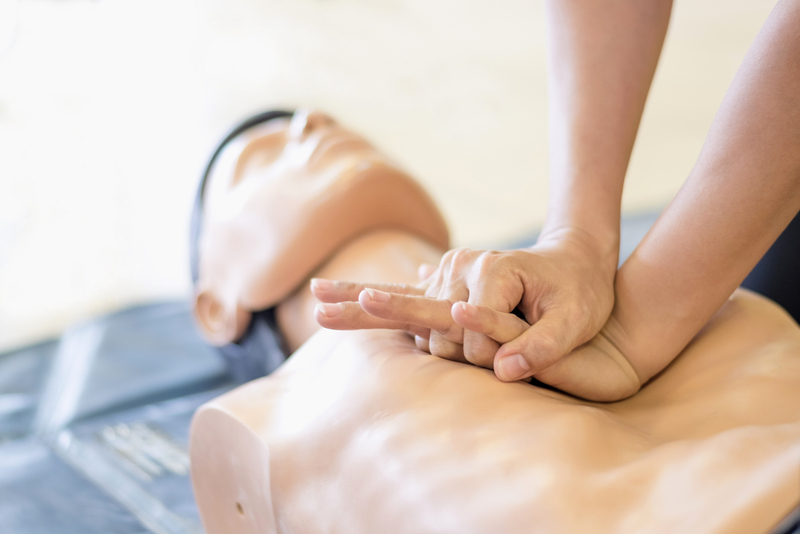5-minute kiosk based CPR program as effective as classroom training
American Heart Association Scientific Sessions 2018 Nov 14, 2018
People who learn Hands-Only Cardiopulmonary Resuscitation (Hands-Only CPR) using a five-minute, kiosk-based program performed CPR as well as those who attended a 30-minute, facilitator-led training session, according to new research by the American Heart Association, the leading voluntary health organization devoted to a world of longer, healthier lives, published today in Annals of Emergency Medicine.

The study financially supported by Anthem Foundation compared CPR performance skills of people who used the kiosk and facilitator-led methods as well as a one-minute training video to learn Hands-Only CPR, a simpler CPR technique that does not require a combination of chest compressions with mouth-to-mouth breaths. The study is the first to evaluate the effectiveness of kiosk-based training for Hands-Only CPR compared to other Hands-Only CPR training methods.
Each year, more than 350,000 cardiac arrests occur outside of the hospital. Almost 90 percent of people who experience a cardiac arrest outside of a hospital die. Survival rates can triple when bystanders perform CPR.
“Less than half of out-of-hospital cardiac arrest victims receive CPR from a bystander, which is a grim statistic that we need to improve, “ said John Meiners, the Association’s Chief of Mission Aligned Businesses and Healthcare Solutions. “The study provides insights on Hands-Only CPR education methods that deepen our understanding of how people can continue to be trained more efficiently and effectively, so they’ll feel empowered and confident to take action.”
The study published in Annals of Emergency Medicine examined three methods of teaching Hands-Only CPR: facilitator-led classroom training, which typically lasts 30 minutes and enables participants to practice CPR with the assistance of an instructor; kiosk-based learning, a five-minute, one-on-one training program that uses high-fidelity manikins that provide feedback on the quality of compressions; and a one-minute, public service announcement video.
The researchers found that people who watched the one-minute training video scored lower than the classroom group in total score, but there were no significant differences in total score between classroom and kiosk participants. The video-only group performed lower on compression depth than the classroom group, while the kiosk group outperformed the classroom group on hand position score but scored lower on compression depth.
Participants in the kiosk session performed as well as those in the classroom session in total score and compression rate. The kiosk users had poorer performance on compression depth, which suggests that this could be an area for improvement in the kiosk’s instruction and feedback.
Because CPR is a psychomotor skill, one that combines mental processes with physical action, the more a person practices, the more they improve, said study co-author Lana M. Gent, Ph.D., Director of Product and Research Innovation at the Association. Based on the study results, kiosk-based CPR training, which is free for participants and located in high-traffic areas such as airports and shopping malls, is a good option for anyone who wishes to learn or reinforce Hands-Only CPR skills, she said.
“We have heard stories from people who have saved a person’s life after learning Hands-Only CPR at a kiosk, as well as stories from healthcare providers who use a kiosk to refresh their skills between flights at an airport, “Gent said. “Based on the findings from this study, we hope to have more kiosks placed in high-traffic locations.”
“Anthem Foundation is working to provide communities across our country with greater access to education, tools and resources that can help them live healthier lives. We’re proud to support the American Heart Association’s innovative use of the Hands-Only CPR kiosks that are helping to remove barriers to learning CPR,” said Stephen Friedhoff, MD, chief clinical officer at Anthem. “Our investment in this education helps people acquire a level of comfort and confidence to perform CPR in an emergency, and the study findings further demonstrate the potential that the kiosks can have on increasing both bystander CPR rates and survival rates from out-of-hospital cardiac arrest.”
With founding support from Anthem Foundation, the Association rolled out the kiosk program in spring 2016. In addition to the Foundation’s continued financial support, the program has expanded with kiosks sponsored by local organizations installed in various cities. To date, the Association has placed 30 Hands-Only CPR training kiosks across the U.S. primarily in airports.
-
Exclusive Write-ups & Webinars by KOLs
-
Daily Quiz by specialty
-
Paid Market Research Surveys
-
Case discussions, News & Journals' summaries
